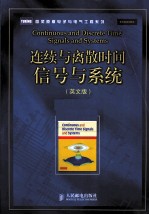图书介绍
连续与离散时间信号与系统 英文版PDF|Epub|txt|kindle电子书版本下载

- (加)曼达尔,(加)阿赛夫著 著
- 出版社: 北京:人民邮电出版社
- ISBN:9787115223944
- 出版时间:2010
- 标注页数:865页
- 文件大小:36MB
- 文件页数:879页
- 主题词:连续控制-信号系统-英文;离散控制-信号系统-英文
PDF下载
下载说明
连续与离散时间信号与系统 英文版PDF格式电子书版下载
下载的文件为RAR压缩包。需要使用解压软件进行解压得到PDF格式图书。建议使用BT下载工具Free Download Manager进行下载,简称FDM(免费,没有广告,支持多平台)。本站资源全部打包为BT种子。所以需要使用专业的BT下载软件进行下载。如BitComet qBittorrent uTorrent等BT下载工具。迅雷目前由于本站不是热门资源。不推荐使用!后期资源热门了。安装了迅雷也可以迅雷进行下载!
(文件页数 要大于 标注页数,上中下等多册电子书除外)
注意:本站所有压缩包均有解压码: 点击下载压缩包解压工具
图书目录
Part Ⅰ Introduction to signals and systems1
1 Introduction to signals3
1.1 Classification of signals5
1.2 Elementary signals25
1.3 Signal operations35
1.4 Signal implementation with MATLAB47
1.5 Summary51
Problems53
2 Introduction to systems62
2.1 Examples of systems63
2.2 Classification of systems72
2.3 Interconnection of systems90
2.4 Summary93
Problems94
Part Ⅱ Continuous-time signals and systems101
3 Time-domain analysis of LTIC systems103
3.1 Representation of LTIC systems103
3.2 Representation of signals using Dirac delta functions112
3.3 Impulse response of a system113
3.4 Convolution integral116
3.5 Graphical method for evaluating the convolution integral118
3.6 Properties of the convolution integral125
3.7 Impulse response of LTIC systems127
3.8 Experiments with MATLAB131
3.9 Summary135
Problems137
4 Signal representation using Fourier series141
4.1 Orthogonal vector space142
4.2 Orthogonal signal space143
4.3 Fourier basis functions149
4.4 Trigonometric CTFS153
4.5 Exponential Fourier series163
4.6 Properties of exponential CTFS169
4.7 Existence of Fourier series177
4.8 Application of Fourier series179
4.9 Summary182
Problems184
5 Continuous-time Fourier transform193
5.1 CTFT for aperiodic signals193
5.2 Examples of CTFT196
5.3 Inverse Fourier transform209
5.4 Fourier transform of real,even,and odd functions211
5.5 Properties of the CTFT216
5.6 Existence of the CTFT231
5.7 CTFT of periodic functions233
5.8 CTFS coefficients as samples of CTFT235
5.9 LTIC systems analysis using CTFT237
5.10 MATLAB exercises246
5.11 Summary251
Problems253
6 Laplace transform261
6.1 Analytical development262
6.2 Unilateral Laplace transform266
6.3 Inverse Laplace transform273
6.4 Properties of the Laplace transform276
6.5 Solution of differential equations288
6.6 Characteristic equation,zeros,and poles293
6.7 Properties of the ROC295
6.8 Stable and causal LTIC systems298
6.9 LTIC systems analysis using Laplace transform305
6.10 Block diagram representations307
6.11 Summary311
Problems313
7 Continuous-time filters320
7.1 Filter classification321
7.2 Non-ideal filter characteristics324
7.3 Design of CT lowpass filters327
7.4 Frequency transformations352
7.5 Summary364
Problems365
8 Case studies for CT systems368
8.1 Amplitude modulation of baseband signals369
8.2 Mechanical spring damper system374
8.3 Armature-controlled dc motor377
8.4 Immune system in humans383
8.5 Summary388
Problems388
Part Ⅲ Discrete-time signals and systems391
9 Sampling and quantization393
9.1 Ideal impulse-train sampling395
9.2 Practical approaches to sampling405
9.3 Quantization410
9.4 Compact disks413
9.5 Summary415
Problems416
10 Time-domain analysis of discrete-time systems systems422
10.1 Finite-difference equation representation of LTID systems423
10.2 Representation of sequences using Dirac delta functions426
10.3 Impulse response of a system427
10.4 Convolution sum430
10.5 Graphical method for evaluating the convolution sum432
10.6 Periodic convolution439
10.7 Properties of the convolution sum448
10.8 Impulse response of LTID systems451
10.9 Experiments with MATLAB455
10.10 Summary459
Problems460
11 Discrete-time Fourier series and transform464
11.1 Discrete-time Fourier series465
11.2 Fourier transform for aperiodic functions475
11.3 Existence of the DTFT482
11.4 DTFT of periodic functions485
11.5 Properties of the DTFT and the DTFS491
11.6 Frequency response of LTID systems506
11.7 Magnitude and phase spectra507
11.8 Continuous-and discrete-time Fourier transforms514
11.9 Summary517
Problems520
12 Discrete Fourier transform525
12.1 Continuous to discrete Fourier transform526
12.2 Discrete Fourier transform531
12.3 Spectrum analysis using the DFT538
12.4 Properties of the DFT547
12.5 Convolution using the DFT550
12.6 Fast Fourier transform553
12.7 Summary559
Problems560
13 The z-transform565
13.1 Analytical development566
13.2 Unilateral z-transform569
13.3 Inverse z-transform574
13.4 Properties of the z-transform582
13.5 Solution of difference equations594
13.6 z-transfer function of LTID systems596
13.7 Relationship between Laplace and z-transforms599
13.8 Stabilty analysis in the z-domain601
13.9 Frequency-response calculation in the z-domain606
13.10 DTFT and the z-transform607
13.11 Experiments with MATLAB609
13.12 Summary614
Problems616
14 Digital filters621
14.1 Filter classification622
14.2 FIR and IIR filters625
14.3 Phase of a digital filter627
14.4 Ideal versus non-ideal filters632
14.5 Filter realization638
14.6 FIR filters639
14.7 IIR filters644
14.8 Finite precision effect651
14.9 MATLAB examples657
14.10 Summary658
Problems660
15 FIR filter design665
15.1 Lowpass filter design using windowing method666
15.2 Design of highpass filters using windowing684
15.3 Design of bandpass filters using windowing688
15.4 Design of a bandstop filter using windowing691
15.5 Optimal FIR filters693
15.6 MATLAB examples700
15.7 Summary707
Problems709
16 IIR filter design713
16.1 IIR filter design principles714
16.2 Impulse invariance715
16.3 Bilinear transformation728
16.4 Designing highpass,bandpass,and bandstop IIR filters734
16.5 IIR and FIR filters737
16.6 Summary741
Problems742
17 Applications of digital signal processing746
17.1 Spectral estimation746
17.2 Digital audio754
17.3 Audio filtering759
17.4 Digital audio compression765
17.5 Digital images771
17.6 Image filtering777
17.7 Image compression782
17.8 Summary789
Problems789
Appendix A Mathematical preliminaries793
A.1 Trigonometric identities793
A.2 Power series794
A.3 Series summation794
A.4 Limits and differential calculus795
A.5 Indefinite integrals795
Appendix B Introducion to the complex-number system797
B.1 Real-number system797
B.2 Complex-number system798
B.3 Graphical interpertation of complex numbers801
B.4 Polar representation of complex numbers801
B.5 Summary805
Problems805
Appendix C Linear constant-coefficient differential equations806
C.1 Zero-input response807
C.2 Zero-state response810
C.3 Complete response813
Appendix D Partial fraction expansion814
D.1 Laplace transform814
D.2 Continuous-time Fourier transform822
D.3 Discrete-time Fourier transform825
D.4 The z-transform826
Appendix E Introduction to MATLAB829
E.1 Introduction829
E.2 Entering data into MATLAB831
E.3 Control statements838
E.4 Elementary matrix operations840
E.5 Plotting functions842
E.6 Creating MATLAB functions846
E.7 Summary847
Appendix F About the CD848
F.1 Interactive environment848
F.2 Data853
F.3 MATLAB codes854
Bibliography858
Index860